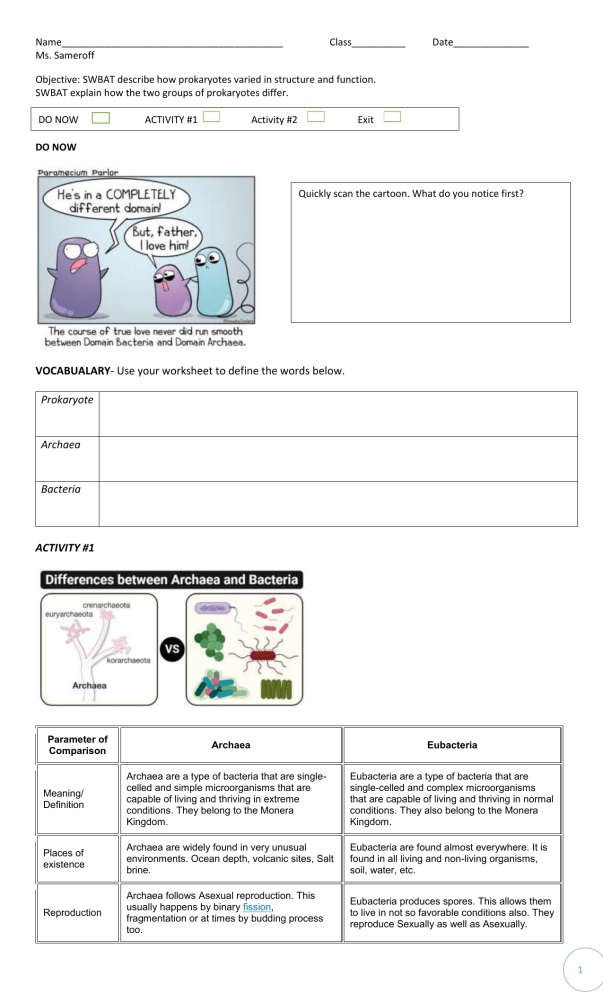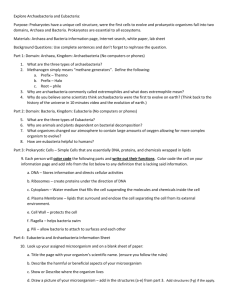
Name_________________________________________ Ms. Sameroff Class__________ Date______________ Objective: SWBAT describe how prokaryotes varied in structure and function. SWBAT explain how the two groups of prokaryotes differ. DO NOW ACTIVITY #1 Activity #2 Exit DO NOW Quickly scan the cartoon. What do you notice first? VOCABUALARY- Use your worksheet to define the words below. Prokaryote Archaea Bacteria ACTIVITY #1 Parameter of Comparison Archaea Eubacteria Meaning/ Definition Archaea are a type of bacteria that are singlecelled and simple microorganisms that are capable of living and thriving in extreme conditions. They belong to the Monera Kingdom. Eubacteria are a type of bacteria that are single-celled and complex microorganisms that are capable of living and thriving in normal conditions. They also belong to the Monera Kingdom. Places of existence Archaea are widely found in very unusual environments. Ocean depth, volcanic sites, Salt brine. Eubacteria are found almost everywhere. It is found in all living and non-living organisms, soil, water, etc. Reproduction Archaea follows Asexual reproduction. This usually happens by binary fission, fragmentation or at times by budding process too. Eubacteria produces spores. This allows them to live in not so favorable conditions also. They reproduce Sexually as well as Asexually. 1 Parameter of Comparison Archaea Eubacteria Cell Wall The cell wall is pseudopeptidoglycan. The cell wall is made up of peptidoglycan with muramic acid or sometimes with lipopolysaccharide. Impact factor Archaea are non-pathogens, meaning they are not harmful and never causes diseases in humans Eubacteria are pathogens, meaning they may cause diseases in humans Classification Prokaryotic Prokaryotic How they get energy Autotroph vs heterotroph Autotroph vs heterotroph What is Archaea? Archaea are single-celled and simple microorganisms that live and thrive in extreme conditions. They are extensively found in places like deep ocean bed, salt brine and also in volcanic eruption sites. They belong to the Monera Kingdom and they are prokaryotes. Archaea are also commonly called as extremophiles. Archaea are of different shapes. A few are flat and square-shaped while many are in the shapes of spirals, rods, plates, and spheres. The cell wall of archaea is made of pseudopeptidoglycan. Archaea have been observed to have lipids linked with ether with the branching of aliphatic acid. What is Eubacteria? Eubacteria are a type of bacteria that are single-celled and complex microorganisms that are capable of living and thriving in normal conditions. They are found almost everywhere in the earth; like the soil, water, living and non-living organisms. The cell wall of eubacteria is made up of peptidoglycan. Eubacteria has ester links with fatty acids. The shapes of Eubacteria are Spherical, rod, cocci, and spiral. The bacteria are enclosed in an envelope which protects and regulates the transport of materials. 2 THINK, PAIR, SHARE Explain the structure of an archaebacterial or eubacteria. Be sure to include three details. __________________________________________________________________________________________ __________________________________________________________________________________________ __________________________________________________________________________________________ __________________________________________________________________________________________ __________________________________________________________________________________________ Activity #2 A prokaryote is a unicellular organism that lacks a membrane-bound nucleus. Bacteria are prokaryotes that fall into two major categories: the Kingdom Eubacteria and the Kingdom Archaebacteria. Eubacteria are common types that occur all around us, usually they are on surfaces and in the soil. You can only find Archaebacteria in extreme environments, like hot sulfur springs. Archaebacteria are thought to be some of the oldest life forms on earth. Most bacteria don't make their own food. That means they must rely on other organisms to provide them with food. These bacteria break down, or decompose, other living things to obtain energy. When most people hear the word bacteria, they think of something that is bad for you. In fact, very few bacteria cause illnesses. Some bacteria actually help you! Bacteria are used to make food, such as cheese and yogurt, and they can also help us break down harmful substances in the environment. Scientists created a type of bacteria that could gobble up oil from oil spills. Some bacteria live inside the guts of animals and help them to digest food. Unfortunately, there are many types of bacteria that can make us ill. Salmonella bacteria can cause food poisoning, and certain types of bacteria are responsible for other infections. You might have had some experience with Streptococcus, the bacteria that causes strep throat. The instructions below describe a typical prokaryote cell, though many bacteria come in different shapes, and sizes and not all contain some of the features described. 1. The cell wall protects the cell and gives it shape. It is the outermost layer on the image. 2. On the inside of the cell wall is the cell membrane. Its job is to regulate what comes in and out of the cell. 3. The surface of some bacteria cells is covered in pilus, which help the cell stick to surfaces. 4. Some bacteria can move within their environment by using structures called flagella, which resemble tails. 5. The watery interior of the cell is called cytoplasm. 6. Throughout the cytoplasm are tiny round structures called ribosomes. Ribosomes make proteins for the cell. 7. Every prokaryote cell has a circular strand of DNA that floats within the cytoplasm. DNA contains the instructions for the cell and controls the cell’s activities. 8. Many prokaryote cells have a small circular loop of DNA called a plasmid. The plasmid is used in sexual reproduction. QUESTIONS 1. What bacteria causes strep throat? 2. What are the oldest life forms on earth? 3. What bacteria is associated with food poisoning? 4. What part of the bacteria cell helps it stick to surfaces? 5. Name two foods that are made with the help of bacteria: 3 6. What does “decompose” mean? 7. What part of the bacteria cell helps it move? 8. Where do Archaebacteria live? 9. To what kingdom do common bacteria belong? 10. What structure controls the cell’s activities? 11. What is the function of ribosomes? 12. What is the function of the cell membrane? 13. What is the watery environment that the DNA and ribosomes float within? 14. Bacteria cells can come in different shapes, some of them even form long chains. Streptococcus is a bacterium that is circular and form chains. The chains can be any number in length. Staphylococcus is a bacterium that is also circular but occurs in clumps. Draw how you would imagine staphylococcus would appear. REGENT QUESTIONS 1. a. b. c. d. Which of the following is a eukaryote? Bacteria Virus Archaea Sperm 2. The food producer within the plant cell uses energy from the sun and converts carbon dioxide and water into sugars. This sub-cellular structure is called the… vacuole. mitochondria. chloroplast. nucleus. a. b. c. d. EXIT TICKET After the lesson, now I understand… ___________________________________________________________________________________________ ___________________________________________________________________________________________ Something I still need help with… ___________________________________________________________________________________________ 4 ACTIVITY #2 True/False : Write true if the statement is true or false if the statement is false. 5 EXIT TICKET After the lesson, now I understand… ___________________________________________________________________________________________ ___________________________________________________________________________________________ Something I still need help with… ___________________________________________________________________________________________ 6 7


